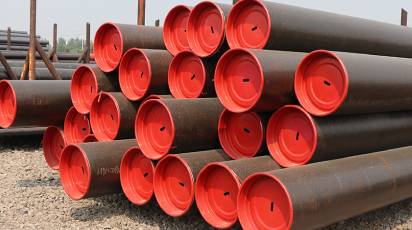1. General pipes: Due to the strong bending resistance of steel pipes, in recent years, steel pipes have been used in roof frames, house beams, and pillars of buildings such as factories and stadiums. For example: Beijing stadium building, Shenyang and other airport terminal buildings. China's high-quality carbon structural steel, low-alloy structural steel, alloy structural steel, and stainless steel, seamless steel pipes produced in accordance with domestic and international standards play an important role in the development of the national economy and the improvement of people's living standards The greater the role.
2. High-pressure seamless steel pipes for thermal power boilers: The process of heating water into steam and superheated steam: When the softened water enters the boiler, it first enters the economizer, and the waste heat of the flame in the furnace is used to heat the economizer. Increase the temperature of the water, and then enter the water-cooled wall tube arranged around the furnace. The water-cooled wall is heated by the burning flame in the furnace. The water in it is converted into steam with water and collected in the drum for water and steam separation. The water enters the water-cooled wall, and the steam enters the superheater located in the upper part of the furnace. The steam is further heated to the required temperature and pressure. Finally, the steam is sent to the steam turbine through the steam duct outside the furnace. After passing through the steam in the steam turbine, its temperature and pressure have been It is greatly reduced, and it is sent back to the boiler, which is heated by the reheater to be superheated steam and reused.
The technical performance of high-pressure boiler tubes is also continuously improved with the development of power plant units. At the beginning of the construction, nearly 10,000 kilowatts were built, and then 100,000 kilowatts, 200,000, 300,000 and 600,000 kilowatts were built. Now the capacity of a single generating unit of the newly built power plant in Pudong has reached 900,000 kilowatts. This requires the temperature and pressure of the steel tube in the boiler to be increased accordingly. For example, the steam pressure gradually increased from the earliest 4Mpa to the current 25-30Mpa, and the steam temperature also increased from 450 ° C to 540-560 ° C. The maximum wall temperature of the superheater and reheater tubes has reached 600-630 ° C. In order to meet the development requirements, the steel of high-pressure boiler tubes has been developed from carbon steel to low-alloy steel, alloy steel, and high-alloy heat-resistant steel containing alloy elements such as chromium, molybdenum, and vanadium. At the same time, the purity of steel is required to be higher.

Oil Line Seamless Steel Pipe
3. Oil production, oil line seamless steel pipe
Oil and natural gas are buried deep in the ground. When oil and gas are to be extracted, first of all, drilling down to the surface (oil wells, gas wells). Drilling tools are used. Except for the drill bits, all of them are connected by steel pipes The drill string is the core drilling tool used to drive the drill bit from the surface to the bottom of the well, and it is also a passage from the surface to the bottom of the well. The drill string is composed of square drill pipe, drill pipe (including a small amount of weighted drill pipe) and drill collar, and most of them are drill pipes. During the drilling process, the drilling rig rotates the square drill pipe, and the drill pipe is connected to the lower end of the square drill pipe, and the drill collar and drill bit are connected to the lower end of the drill pipe. Therefore, the drill pipe plays a role in transmitting power and transporting mud. As the borehole continues to deepen, the drill rods should be added one after the other and connected to continuously lengthen the drill string to the specified depth. During the drilling process, a casing is inserted to support the wall of the oil and gas well according to the formation conditions. Drilling a well, according to different depths and formations, usually requires multiple layers of casing, namely surface casing, technical casing and oil (gas).
